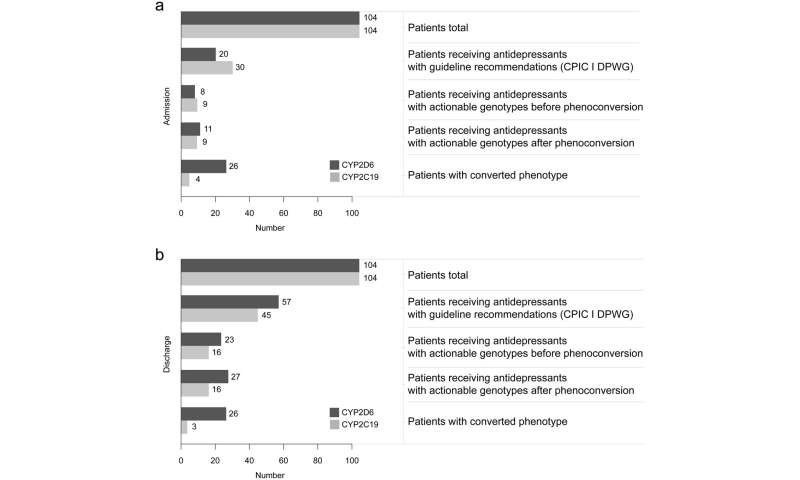Divergent phenotypes, actionable genotypes, and phenoconversion in a German psychiatric inpatient population

Genetic polymorphisms of CYP2D6 and CYP2C19 affect both the effectiveness and the occurrence of side effects of many antidepressants. By drug-drug-gene interactions (also referred to as phenoconversion), the phenotype of the patient can be changed.
Both pharmacogenetic testing, drug-drug, and drug-drug-gene interaction checks are essential to individualize the dose of the antidepressant or start an alternative drug in accordance with the pharmacogenetic guidelines.
The aim of this study was to analyze the frequency of divergent phenotypes (i.e., divergent from the common phenotypes considered normal), phenoconversion (a genotype–phenotype mismatch), and actionable genotypes (genotypes where a prescribing change may be indicated) in psychiatric inpatients with a depressive disorder.
Genotyping of CYP2D6 and CYP2C19 was performed in 104 patients 18 years of age or older who received inpatient treatment in a German psychiatric university hospital for a depressive disorder. Representation of the frequencies of divergent phenotypes, phenoconversion, and actionable genotypes were analyzed.
A divergent phenotype in one or both CYP enzymes was seen in 83.5% of the patients. The rate of CYP2D6 poor metabolizers increased by 142.4% (from 5.9% to 14.3%, p = 0.013) at admission and by 183.1% (from 5.9% to 16.7%, p = 0.004) at discharge because of phenoconversion.
At discharge, 22% of the patients (n = 104) received an antidepressant with a dosing recommendation based on their CYP2D6 phenotype and 15.4% on their CYP2C19 phenotype. When considering phenoconversion, the rate increased by 17.4 to 26.0% (p = 0.221) for patients with the CYP2D6 genotype.
Many previous studies neglected the effect of phenoconversion, potentially leading to a failure to find a correlation between genotype and plasma drug concentration. The relevance of pharmacokinetic drug interactions depends on the patient's genotype, which explains why interactions may lead to clinically significant changes in some patients but not in others. This is also reflected in the different assessments of interactions in interaction databases.
An evaluation of pharmacokinetic interactions is only possible when the genotype is known, which underscores the importance of PGx testing in clinical practice. In psychopharmacotherapy, agents that induce phenoconversion are frequently used, such as paroxetine, fluoxetine, duloxetine, and bupropion, and can lead to CYP inhibition and consequently to toxic effects due to the enrichment of substrates.
The findings are published in the Journal of Exploratory Research in Pharmacology.
More information:
Andreas Eckert et al, Divergent Phenotypes, Actionable Genotypes, and Phenoconversion in a German Psychiatric Inpatient Population: Results from the FACT-PGx Study, Journal of Exploratory Research in Pharmacology (2024). DOI: 10.14218/JERP.2023.00042
Provided by Xia & He Publishing Inc.